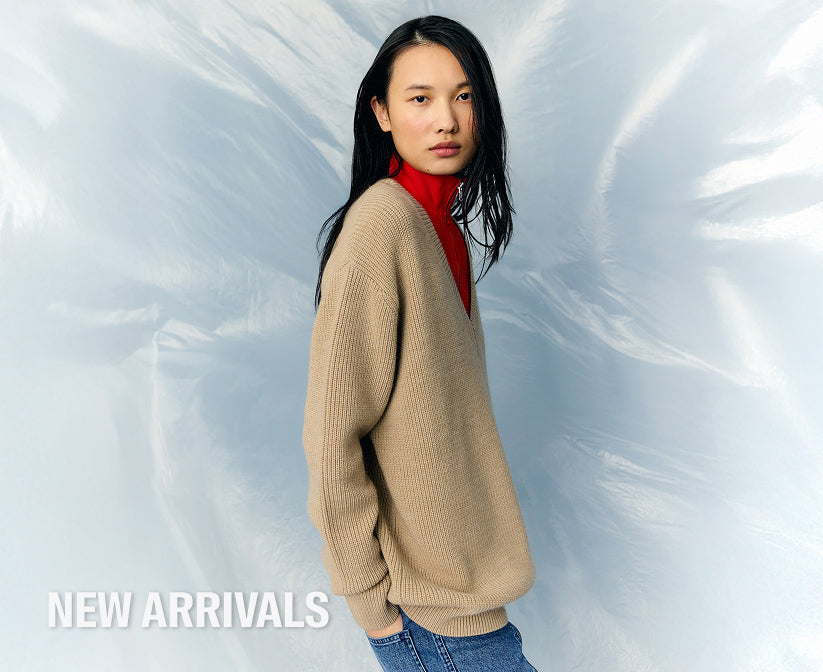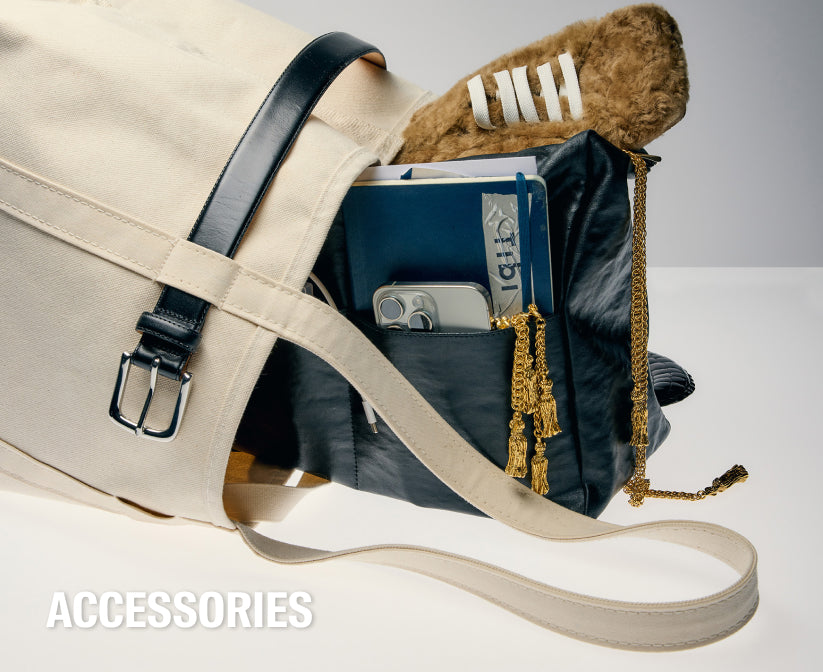A good fit is subjective. What I mean by this is, often it lies literally in the eye of the beholder. My idea of relaxed and eased can be someone else’s concept of feeling overwhelmed in their clothes. Sexy for me may be the way a shirt is unbuttoned just so or how a dropped shoulder on a blazer exudes a bit of indifference in the best way possible. For others, it may be how a skirt hugs across the bum, or the sleekness in a super narrow trouser. The point? We all have different ideas and unique motivations. And, did I mention a diverse range of body shapes?
The fact that we are all built slightly differently I cannot control. But, what I can control is a consistency in how we approach design, so that when you try, when you buy, you have some level of understanding of how we view fits coupled with the high level of technical consistency that we’ve honed over the last 20+ years. So, I will share this knowledge with you. It will make you smarter about how you shop - not just with Tibi, but in general. You’ll be able to spot when a model on a website has sized up 3x in a style to get an ease that may not ever truly materialize on you because of the way an armhole is inset or the width of the muscle on the sleeve. You’ll be in a better position to judge when sizing down will make you feel better or like a balloon about to pop. Here’s the information - some objective, some subjective, and much in between. Ok?
Generally speaking, there are six ranges of bottoms (skirts, pants, shorts) that a designer can offer. At Tibi, we build a “block” for each of these. This is why, season after season, you can buy an item and it will have a consistent fit. This doesn’t mean, however, that you are limited and will look repetitive. While the key measurements points on the body are limited, the way a designer interprets them can be limitless.
Let’s do a deeper dive here on bottoms to ensure we are all on the same page.
High-Waisted and Full
Just like the name implies - this is designed to sit right at the natural waist. Here’s an easy trick to find your natural waist. Bend your elbows and put both hands on your waist - where do they naturally gravitate to? That’s your natural waist - it’s usually the narrowest part of your torso. It’s clear from the sketch below that the waist is the critical measurement here. The measurements of the style should be around one inch or 2.54cm, greater than your natural waist. So that you are comfortable. So you can eat - eating is good.
Now, depending if a waistband has stretch, or if the fabrication has movement, these measurements may vary slightly. But the extent of a block, across any fabrication or design treatment, is to ensure that the size 10 high-waisted full item you bought last year will have a similar fit to what we offer this year. And the next.
Explore High-Rise Full Styles ⟶
High-Waisted Slim
Designed to sit at waist and be tailored to the body through the hips and thigh area. The waist, hips and thigh are all critical measurements here. Especially if the item has no stretch. If the item does have stretch, sizing down will result in a more fitted look. Maybe sexier, however you want to read in to that. If it does not have stretch, sizing down will just make you uncomfortable. If you size up in the pant, it will likely require some tailoring. Some fabrications size up easier than others. A soft silk, for example, will still drape, so if you’re wearing a larger size the fabric will not create a hump at your hips in the way a more structured fabric would. The visuals will explain this nicely.
Mid-Waist Full
This is designed to sit just below the waist and above the high hips for a relaxed vibe. The zipper lengths tend to be longer and the waist opening straighter, which tends to visually communicate ease. This is highly intentional and this relaxed but polished emotion is Tibi’s signature.
Because the rise on styles meant to sit below the waist are longer, it means you have options, and options are good. If you want to wear them higher and cinched with a belt you can. No camel toes included. If you want to size down for a curvier effect you can. As you see here:
Remember, when we refer to items as oversized or made with fullness and ease, the style itself is engineered to be exactly that. You do not ever “size up” to achieve how we have described the style.
Explore Mid-Rise Full Styles ⟶
Mid-Waist Slim
Designed to sit just below the waist above the high hips for a relaxed “vibe” - which is not the same as a relaxed “fit.” Here’s why. With a style that has a slimmer fit, it’s more important than ever to give visual cues that you are a person who has an ease about you. We do this through the longer zipper lengths, the straight waistband, and placing the pocket opening low on the hips. When you evaluate which size is best for you, each measurement point is important. If it is an item without stretch, the measurements should be slightly larger than your body’s measurements. So that you can breathe, which we care about.
Low and Full
The ultimate in chill and ease. Designed to sit at just above the hips. The zipper length is elongated visually to still convey ease, but not so much that it changes the fit to a drop crotch style. That is not the intent of the style. The top opening (I hesitate to call it a waist opening anymore because it is meant to sit so low) is quite large as it is designed to land at the high hip area. When the style is full, it is quite easy to size down in the style to effect a different vibe. If you choose to do this, the style will hit much higher at the waist, be more fitted through the bum, and you will lose the ease in the rise. Which is fine if that’s what you’re going for. Of course, please remember that the higher you move the pant up on the waist, the shorter the pant will be in length.
Low and Slim
We work extra hard with this style to give it a modern vibe and not fall into a trap that can feel a little too…..hmm. I’ll let my illustrations do the talking here. Because this style is designed to sit close to the body, the hip measurement is most important. If your hips and waist don’t match the chart closely enough - one is bigger or smaller than the other - go with the hip measurement every time in this style. If the item has a lot of stretch, then there’s always wiggle room to size down for an even more fitted style. But if it’s a tailored fabrication, make sure that your body measurements are really close to or just below the blocks’ measurements.
Below are general measurements for our building blocks we have set up for High, Mid and Low rise items. You’ll understand now why the waist measurement varies greatly depending on where the item is designed to sit on the body. Remember this is the block that we use when creating a new pattern; there are considered changes we may make depending on how a fabric behaves. But this will help you get in the right place when thinking what items will make you feel the way you hope.
The Engineered Oversized Blazer
When evaluating the fit of a blazer, the amount of ease engineered into the style is important to consider. An oversized blazer with a drop shoulder will never become “fitted” even when you size down three sizes. Conversely, a tailored blazer will never have the oversized ease you imagine by sizing up. The inset arm hole, any waist shaping will leave the blazer feeling more awkward than chill. Now, that said, there are times when sizing up is a solid consideration. I find that with oversized blazers, height can be more important than any other measurement. I had a size 16 client, 5’2” tall, who wore the size medium perfectly. Could we button it up completely? No. Have I ever worn mine buttoned up? No, never. I’ve never even sent it down a runway that way. It’s funny, sometimes we know we’ll wear something only one way, because we love it that way, but the fact we can’t wear it the other way becomes a stumbling block to buying what we love. She got over it. It was all good and now she has a blazer she lives in - and it’s a medium. I’ve also had size 2, 5’11” tall customers who were much happier in a size large. The proportions worked better. Here’s a visual on this - you can see that the tall individual can easily size up and the shorter one can easily size down. Your choice.
The Tailored Blazer
This style sits closer to the body. I said closer, not fitted. You won’t find fussy seaming here or a nipped in waist. The vibe is still chill and easy, but your seam will hit right at the shoulder. The armhole will be at your armhole. Your shoulder and bust measurement are the two most important considerations here. The effect will not be overly boxy, it will be just perfectly eased but undoubtedly put together.
The Slim Blazer
This blazer is purposely designed to follow the curves of the body whether through sculpting, seaming or stretch fabrications. The shoulder, bust and waist are all important considerations, especially in any styles in non-stretch fabrications. Your measurements should closely mirror the specifications of the style.
Explore Tibi.




